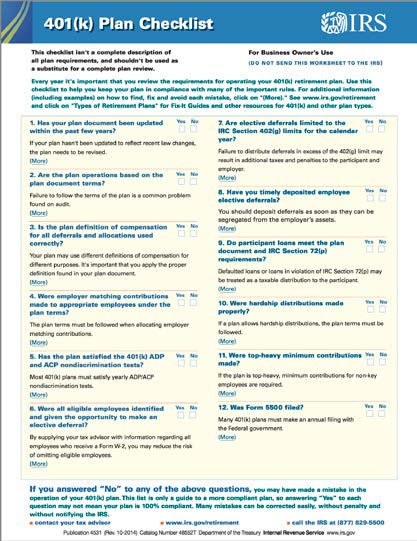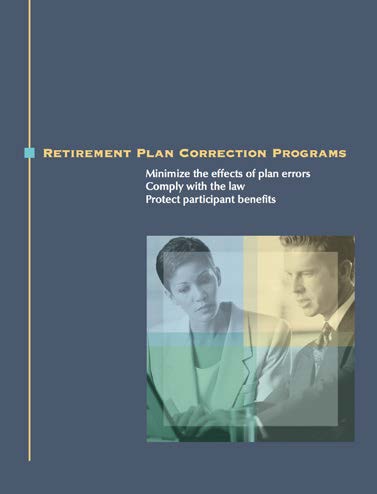Although advisors are not typically involved in day-to-day plan administration, you have an opportunity to strengthen your relationships with existing plan sponsor clients by providing education about the importance of administrative compliance and introducing strategies for avoiding operational missteps. Discussing compliance support services with prospective clients also provides an opportunity to illustrate the depth and breadth of your retirement plan expertise and differentiates your services from those of your competitors.
Conducting proactive self-audits of plan operations to identify operational mistakes and establishing internal controls are two best practices you can introduce to plan sponsors to help them maintain compliance. The IRS has developed resources and checklists you can provide to help plan sponsors review plan operations and fix mistakes they uncover.
Tax Code Compliance
To benefit from the tax advantages of offering a retirement plan (e.g., deductions for employer contributions and tax-deferred savings for participants), plan sponsors must comply with the retirement plan rules set out in the Internal Revenue Code and the accompanying Treasury regulations. This includes the rules that limit the amount of contributions and require nondiscrimination tests.
The IRS is responsible for enforcing the tax laws relating to retirement plans and for monitoring the written plan documents that must be used to establish a retirement plan. Although the IRS has the authority to assess penalties, taxes, interest charges, and even to invoke plan disqualification if a plan is not in compliance, the primary IRS goal is for the plan sponsor to make the necessary changes to bring the plan back into compliance.
One way the IRS promotes plan compliance is by alerting plan sponsors to the most common problems found on IRS examinations.
Common Plan Mistakes
- Excluding eligible employees from making elective deferrals
- Allowing contributions to exceed permissible limits
- Using an incorrect definition of compensation to calculate plan contributions
- Not timely correcting failed ADP/ACP tests
- Missing required minimum distributions
- Failing to timely amend plan documents
Self-Audits
The IRS encourages plan sponsors to conduct periodic self- audits of plan operations to find operational mistakes. You can equip plan sponsors with the tools to conduct regular self- audits and fix mistakes by introducing them to the IRS’s 401(k) Plan Checklist and 401(k) Plan Fix-It Guide. You may want to include the plan’s recordkeeper or third party administrator (TPA) in the self-audit process to help the plan sponsor review or verify certain aspects of plan operations.
The checklist asks a series of questions to help plan sponsors focus on common operational mistakes made in retirement plans. After each question, the checklist provides links to applicable sections of the fix-it guide, which contain explanations of how plan sponsors can determine whether a mistake has been made, how to fix the plan mistake, and how to avoid the mistake in the future.

irs.gov/pub/irs-pdf/p4531.pdf
Internal Controls
In addition to promoting self-audits, the IRS has also developed educational tools to help plan sponsors understand the importance of establishing internal controls to drive appropriate plan operations. Internal controls are policies and procedures put in place to make certain that the plan is being operated in compliance with their plan document and the tax laws governing retirement plans. By establishing formal procedures for monitoring plan operations, plan sponsors can proactively safeguard their retirement plans from missteps. Strong internal controls establish and document procedures for verifying that the plan is being operated according to its written terms and determining whether the plan document needs updating or modification.
Sample Internal Control Procedures
- Confirming plan loans and distributions followed the terms of the plan document
- Comparing salary deferral election forms with the amounts deducted from employee wages
- Checking that plan service providers received accurate compensation data and ownership records
- Ensuring all required minimum distributions have been made
The IRS has developed a list of questions you can use to help plan sponsors document and evaluate their plan’s policies and procedures: irs.gov/retirement-plans/policies-procedures-and-internal-controls-self-audit.
Corrections Resources
If a plan sponsor uncovers an error in plan documentation or operations, the IRS has a plan corrections system in place that lets plan sponsors bring their plan back into compliance without losing its tax benefits: the Employee Plans Compliance Resolution System (EPCRS). EPCRS is designed to improve overall plan compliance by promoting voluntary corrections without penalty or for a reduced fee rather than waiting until an error is discovered under an IRS audit. The EPCRS offers three levels of corrections programs:
1. Self-Correction Program (SCP) – for correcting recent or insignificant operational errors, such as an improper exclusion of employees, without any IRS involvement or fee
2. Voluntary Correction Program (VCP) – for correcting operational or document qualification failures discovered before an IRS audit, such as failure to amend the plan document, with a fee that is based on the number of participants in the plan and in some cases, the particular failure being corrected, and that is lower than fees that would be assessed by IRS examiners
3. Audit Closing Agreement Program (Audit CAP) – for correcting significant problems discovered in an IRS audit, with a penalty based on the amount of tax benefits preserved, the extent of the failure, and whether corrective actions were taken before audit
For more information on the IRS’s correction programs, visit irs.gov/Retirement-Plans/Correcting-Plan-Errors.
As you discuss the potential for compliance errors with plan sponsors, you may want to introduce the IRS’s correction program to plan sponsors. You can also help plan sponsors identify plan corrections service providers such as TPAs or ERISA attorneys, who can assist with the corrections calculations and documentation.
The DOL also offers self-correction programs for violations that occur under their jurisdiction. For example, plan sponsors may use the Voluntary Fiduciary Correction Program (VFCP) to correct fiduciary violations such as late deposit of employee contributions or payment of improper plan expenses. The IRS and DOL jointly produced a brochure to help explain these correction programs to plan sponsors.
Financial Advisor Support
As you educate plan sponsors about their responsibilities for maintaining operational compliance, you can provide valuable support by
- Encouraging plan sponsors to conduct annual self-audits to catch mistakes early
- Helping plan sponsors develop internal control procedures
- Facilitating a discussion with the plan’s TPA or recordkeeper to review administrative practices
- Incorporating free IRS self-audit tools and educational resources to complement your plan compliance discussions
- Helping plan sponsors identify resources for plan corrections support such as a TPA or an ERISA attorney










